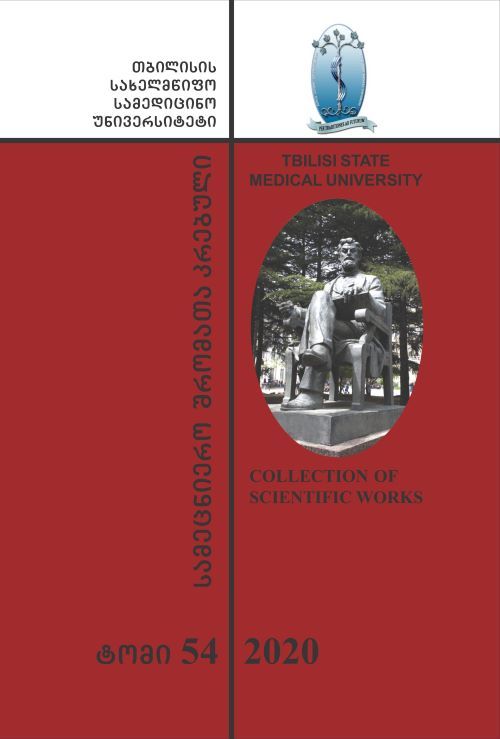Abstract
The assessment of age variation in tendon ultrasound features during shoulder joint traumatic and chronic pathologies. 100 patients participated in the study (17-83 y/o. mean age 57.56± 12.88 y/o.); The study contingent was divided into 2 groups: 1. Patients with less than 60 years (n=56; mean age - 48.93 ± 8.85y/o). 2. Patients whose age is greater than or equal to 60 years (n=44; mean age - 68.93 ± 6.73y/o). Percentage distribution of lesions caused by trauma (respectively, n=11, 19.54% vs. n=12, 27.27%%) and chronic pathologies (respectively, n=45, 80.46% vs. n=32, 72.73%) are uniform in these groups. Chronic pathologies include: degenerative -dystrophic and chronic inflammatory pathologies (tendinitis, tendinosis, tendinopathy, subacromial-subdeltoid bursitis). Ultrasound study performed on ultrasound TOSHIBA xario XG by high linear probe (7,5-12.0 MHz) with dopplerography (color, energetic), transverse and sagittal planes. It has been evaluated the impact of age on shoulder joint tendons (BT, SSP, ISP, SSC) ultrasound parameters: thickness (diffuse, local, normal), echostructure (markedly inhomogeneous, slightly inhomogeneous, normal), echogenicity (increased, decreased, normal), continuity of contours (Intermittent, normal).
References
Favard L, Bacle G, Berhouet J. Rotator cuff repair. Joint, Bone, Spine: Revue du Rhumatisme 2007, 74(6):551557.
Matsen FA 3rd. Clinical practice. Rotator-cuff failure. New England Journal of Medicine 2008, 358(20):21382147.
Lewis JS. Rotator cuff tendinopathy. British Journal of Sports Medicine 2009, 43(4):236241.
Baring T, Emery R, Reilly P. Management of rotator cuff disease: specific treatment for specific disorders. Best Practice and Research. Clinical Rheumatology 2007, 21(2):279-294.
Nho SJ, Yadav H, Shindle MK, Macgillivray JD. Rotator cuff degeneration: etiology and pathogenesis. American Journal of Sports Medicine 2008, 36(5):987-993.
Wendelboe AM, Hegmann KT, Gren LH, Alder SC, White GL Jr, Lyon JL. Associations between body-mass index and surgery for rotator cuff tendinitis. Journal of Bone and Joint Surgery. American Volume 2004, 86A(4):743-747.
Luime JJ, Koes BW, Hendriksen IJ, Burdorf A, Verhagen AP, Miedema HS, Verhaar JA. Prevalence and incidence of shoulder pain in the general population; a systematic review. Scand J Rheumatol. 2004;33(2):73-81.
Ottenheijm RPG, Cals JWL, Winkens B et al. Ultrasound imaging to tailor the treatment of acute shoulder pain: a randomised controlled trial in general practice. BMJ Open 2016, 6:e011048.
Singh A, Thukral CL, Gupta K, Singh MI, Lata S, Arora RK. Role and Correlation of High Resolution Ultrasound and Magnetic Resonance Imaging in Evaluation of Patients with Shoulder Pain. Pol J Radiol 2017, 82:410-417.
Fischer CA, Weber MA, Neubecker C et al: Ultrasound vs.MRI in the assessment of rotator cuff structure prior to shoulder arthroplasty. J Orthopedics 2015, 12(1):2330.
Roy JS, Braën C, Leblond J et al: Diagnostic accuracy of ultrasonography, MRI and MR arthrography in the characterisation of rotator cuff disorders: A meta-analysis. Br J Sports Med, 2015, 49(20):1316-1328.
Kamath SU, Chajed PK, Nahar VP. Correlation of clinical finding with ultrasound diagnosis of rotator cuff pathology. Research & Reviews. Journal of Medical and Health Sciences, 2014; 3(2):1-8.
Redondo-Alonsoet L, Chamorro-Moriana G, Jimenez-Rejano JJ, Lopez-TarridaP, Ridao-Fernandez C. Relationship between chronic pathologies of thesupraspinatus tendon and the long head of thebiceps tendon: systematic review. BMC Musculoskeletal Disorders2014, 15:377-386.
Singaraju VM, Kang RW, Yanke AB, McNickle AG, Lewis PB, Wang VM, Williams JM, Chubinskaya S, Romeo AA, Cole BJ. Biceps tendinitis in chronic rotator cuff tears: a histologic perspective. J Shoulder Elbow Surg. 2008;17(6):898-904.
Braun S, Horan MP, Elser F, Millett PJ. Lesions of the biceps pulley.Am JSports Med2011,39(4):790-795.
Modi CS , Smith CD, Drew SJ. Partial-thickness articular surface rotator cufftears in patients over the age of 35: Etiology and intra-articular associations.Int J Shoulder Surg 2012,6(1):15-18.
Chelli Bouaziz M, Jabnoun F, Chaabane S, Ladeb MF. Diagnostic accuracyof high resolution ultrasound in communicating rotator cuff tears.Iran J. radiology 2010,7(3):153-160.
The value of radiographic markers in the diagnostic work-up of rotator cuff tears, an arthroscopic correlated study Jeroen J. van der Reijden, Syert L. Nienhuis, Matthijs P. Somford, Michel P. J. van den Bekerom, Job N. Doornberg, Esther van `t Riet & Maaike P. J. van den Borne Skeletal Radiology volume 49, pages5564(2020)Cite this article. Scientific Article
